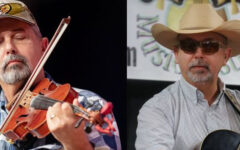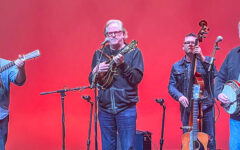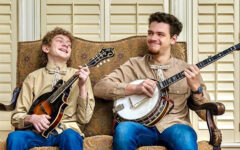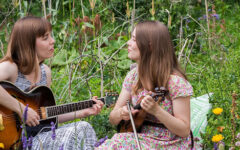
Maureen Blumenthal is a third generation San Francisco Bay Area native and a mainstay of the California bluegrass community. She’s a West Coast Songwriter award-winning singer/songwriter of the two main forms of music: country AND bluegrass. Mo is active in the Harlan James Bluegrass Band, and performs with duet partner Richard Mason in the cleverly named Mo B. & Dick. Her songs pull on emotional heartstrings and are full of great county double entendres such as my favorite, “If you’re not here beside me, I’m beside my self.”
When did you start getting into bluegrass music?
It was 1973. I met a guy named Bob. Isn’t that how the story often goes? He was into bluegrass and had a sweet-sounding old RCA console record player with a HUGE speaker. He put the needle down on a Country Gentlemen record, and I got goosebumps. It was the heyday of Paul’s Saloon in San Francisco. Over the next few years I saw the best Bay Area bands play there – High Country, the Phantoms of the Opry with Pat Enright, the Good Old Persons. I started listening to bluegrass radio shows and collecting bluegrass records. I was a fan but not a musician – that came much later. Bob and I have sung bluegrass and country songs together in the privacy of our own home over the years. He’s more into the Great American Songbook now, with all the weird jazz chords. I don’t hold it against him, though. We’re still together.
What instruments do you play?
“Play” is loose definition. I was AARP-eligible when I took my first banjo lesson. I was even older when I learned to hold a flatpick to play bluegrass rhythm guitar. I got a mandolin a couple of years ago and can pick out a few tunes. Nothing fast. I’ve got a decent ear, but my brain and hands don’t seem to cooperate with each other. I learned some guitar chords during the “Folk Scare” of the ‘60s, enough to be trotted out with my sisters when my parents had guests over. We’d sing Puff the Magic Dragon and beat a hasty retreat. I’m still not crazy about performing, so I didn’t really get comfortable playing any instrument, especially in front of people, until… well, I’m still flailing away. However, I’ve at least reached an age where I don’t care if I blow a break in a jam. I just forget it and move on. No one’s going to die, right?
How would you describe your banjo style?
I‘d call it Scruggs-ISH. I play with three fingers, but I can’t keep to roll patterns to save my life. I just try to find the melody and play some random stuff around it that I hope sounds nice. Out of necessity I play more guitar now, since I have to accompany myself when I sing my own songs.
What bands are you active in and where do you play?
I play banjo and guitar with the Harlan James Bluegrass Band. We don’t gig very often, but we get together a couple of times a month anyway. I met the others at the Fifth String in Berkeley in 2008, where Ran Bush ran a slow jam and organized some workshops for beginners. At this point we’re more of a family than a band. I also play with Richard Mason, as Mo B. & Dick. I met him at Walker Creek Music Camp several years ago. We do old country songs – Charlie Poole, the Louvins, Hazel and Alice, Hank Williams, Carter Family – anything that works well as a duet. We both write songs, so we work our originals in when we can. We make the rounds of the retirement communities but play at public venues too.
Tell us more about the release, Beside Ourselves, and where can people purchase it.
We recorded it at Gawain Mathews Studio in Pinole. Over the last few years I’ve won a lot of free recording time at West Coast Songwriters competitions, and Gawain is one of the folks who donates studio time. Dick and I both liked working with him immediately, so when we decided to record a whole Mo B. & Dick CD, he was a natural choice. We haven’t put the “record” on CD Baby or Spotify or iTunes yet. We haven’t thought far enough ahead as to how we’d deal with a media presence. If anybody wants to buy a CD, I’ll bring some to Walker Creek Music Camp in April and to the CBA camp and festival in Grass Valley in June. If you google Maureen Blumenthal or Mo B. & Dick, there are a bunch of random videos on YouTube.
You’re pretty involved in the CBA music camps. What’s your role?
I started as a student, but for the last few years I’ve been a volunteer. I feel I owe my life in bluegrass in large part to the CBA Music Camp, so volunteering is a no-brainer. I’ve been a teaching assistant to a lot of my California heroes – Kathy Kallick, Jim Nunally, Laurie Lewis, Keith Little – and try to help out in workshops and jams. Of course there are the less glamorous tasks, like schlepping chairs, erecting pop-ups and such, but it’s all rewarding.
Do you teach elsewhere?
As a service to women bluegrassers, I do a monthly women’s bluegrass harmony practice session at my home in Oakland. It’s free. Unless you have a natural gift for singing harmony, you have to listen and practice a LOT! We sit around the kitchen table and try to hear the buzz. I help them find the parts. Men want to join, but the ladies want this night to themselves. I guess I’ll have to start a coed session.
If you could, what advice would you give to a young Maureen?
Buy that $400 Loar in 1974? But seriously, I think she was wiser than I am now. The older I get the less I feel qualified to give advice.
Tell us about your songwriting endeavors.
I’m a late bloomer in that department too. When I started out playing with other people, I felt like a sheepdog must feel when it sees its first sheep, like “Oh, that’s what I’m made for!” With my knees shaking and my heart in my throat, I first sang one or two of my originals at CBA camp one night at a song circle led by Topher Gayle. He was very encouraging, as was Richard Brandenburg at the next song circle I attended. That helped me a lot, to know that I was on the right track. I still get nervous, but it’s getting easier. I force myself to go to the West Coast Songwriters competition each month in Berkeley. For me it’s like flossing my teeth; not particularly enjoyable, but necessary to get performance practice and feedback from other songwriters who are actually paying attention. For the same reason, I belong to a monthly songwriters exchange where we do our newest works in progress.
What differentiates a good song from a great one?
That’s subjective. For me, both the melody and the lyric have to be memorable, and both have to serve the emotional arc of the song. I like story songs especially, with a beginning that draws you in, a middle journey that has a bit of tension, and an end release that ties it all together. And enough imagery so it’s like a little movie you can play in your head. But that’s just me.
How do you go about getting songs recorded by others?
I’m shy about foisting my songs on people, so the only way for me so far has been for someone to say, “Hey, Mo, pitch me some songs.” That’s what Keith Little did. I thought he was just being nice. But I sent him some songs and he’s performed two that I know of, one of which he’s recorded. So anybody out there in Bluegrass World or Country Land who wants some new material, just ask me!
What songs of yours did Keith Little sing and where can we hear them?
The songs are Back to the Headwaters and At Mission Dolores. I don’t have recordings, just scratch takes, though a few people sent me videos they shot at Strawberry when Keith first performed them with the Little Band. I’m not sure Keith would like to disseminate them. The band was still working them out, so they’re a bit rough. I haven’t put any effort into recording them myself. I love writing a song, but it’s plain hard work preparing it for performance, especially since I’d rather have an experienced musician and singer take it off my hands. I did one 45-minute set of my own songs alone at the Bazaar Cafe in San Francisco a couple years ago, and people urge me to do more. It’s so grueling, though. And I’m a champion procrastinator.
What songwriters do you continue to study and why?
I like to see songwriters perform live and I listen to their recordings, but I don’t study the songs too intently. That would be too much input that I can’t dump from my brain, and I already worry that I’m unconsciously stealing what I hear. I could mention some songwriters I admire, though: Hank Williams, Merle Haggard, Joni Mitchell, Willie Nelson, Hazel Dickens, Dolly Parton, Gillian Welch – they’re pretty famous. Less famous favorites are Robbie Fulks, Chris Stuart, Chris Brashear, Mark Graham, and Maurice Tani. And of course, Kathy Kallick and Laurie Lewis! Inspirations, for sure, who got me thinking about songwriting in the first place.
How has the bluegrass scene changed in the last ten years or so?
I can’t see the big picture because I don’t travel well. Just going to Grass Valley is like the Grand Tour for me. I stick pretty close to home, so I can only speak about the East Bay. When I started going to jams, about ten years ago, I was often the only woman in the jam. I felt either patronized or ignored. That’s certainly changed. More women are stepping into the circle, and the men are making room. There are also more resources for people wanting to learn bluegrass. Both the Freight and Salvage and Manning Music in Berkeley have group classes. And even though the Berkeley Fifth String closed, the Stork Club in Oakland has a weekly jam, as does Music Works in El Cerrito. In a real sense I’m as much a product of the East Bay bluegrass scene as I am of the CBA.
What do you do when not playing music?
I LISTEN to music. I go out to see live shows. I watch too much TV, but it’s usually PBS, so I don’t feel too guilty about it. Bob and I like to walk around the local parks and bird-watch.
Thank for your time Mo, it is an honor to share your story.
Thank you, Dave. I’m honored that you’re honored to interview me.
Thanks to copy editor Jeanie Poling.







